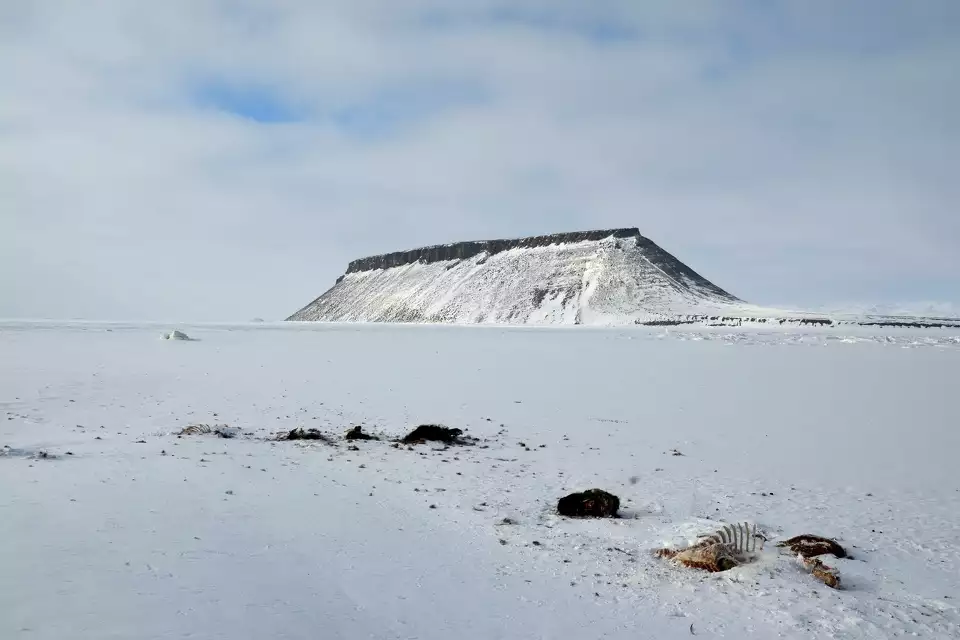California Scientists Accidentally Find Nuclear Fever Dream in Arctic Snow

In an unexpected discovery that has scientists and environmentalists alike scratching their heads, a team of researchers from California recently uncovered traces of a mysterious and alarming substance buried in the snow of the Arctic region.
The completely unanticipated findings have sparked intrigue and concern, raising questions about the potential implications for both the environment and public health.
The team, part of an ongoing study aimed at analyzing the effects of climate change and atmospheric pollutants in the polar regions, was conducting a routine snow collection when they made their shocking find.
Among the usual samples of particulate matter, they stumbled upon what they believed to be traces of a substance linked to nuclear activity.
The substance, which experts are referring to as a “nuclear fever dream,” has been tentatively identified as a radioactive compound, but its exact origin remains unclear.
The Discovery: A Routine Expedition Turns Alarming
The California-based scientists, part of a larger environmental monitoring project, were initially focused on collecting snow samples to study the long-term effects of airborne pollutants and particulate matter.
The project, which has been ongoing for several years, aims to track the movement of environmental contaminants and their accumulation in remote regions like the Arctic.
However, during one of their routine sample collections in the snow, the researchers discovered something that wasn’t supposed to be there.
One of the snow samples, which was tested in a laboratory, contained unusually high levels of an unidentified radioactive substance.
Further tests suggested that the material had characteristics consistent with compounds linked to nuclear processes, though it did not match any known isotopes from common nuclear activities like power generation or medical isotopes.
This has led researchers to theorize that the substance could be the result of some sort of unrecognized or previously undetected nuclear event, but its presence in such a remote, pristine environment raises more questions than answers.
The team was initially taken aback by the discovery. While radiation from natural sources is not uncommon, the specific nature of the compound discovered raised alarms. Given the remote nature of the Arctic, the presence of nuclear material in the snow was both unexpected and troubling.
The scientists immediately flagged the discovery, and a series of follow-up investigations have been launched to determine the full extent of the contamination and its potential origins.
A “Nuclear Fever Dream” — What Does It Mean?
The term “nuclear fever dream” has been coined by the scientific community to describe the strange, almost surreal quality of the discovery. It suggests that the material found in the snow is not just a simple trace of radioactive material, but something more enigmatic.
The exact nature of the material remains a puzzle, but early indications suggest that it may be a rare or previously undetected byproduct of nuclear activity, possibly from an event that occurred far from the Arctic itself.
One theory that has emerged is that the radioactive material could have come from past nuclear tests, particularly those conducted during the Cold War era.
While most of the world’s nuclear tests took place in more remote locations, the global atmospheric circulation patterns are such that radioactive particles can travel vast distances before eventually falling to Earth. The material discovered in the Arctic snow may be a remnant of one of these tests, carried far from its origin by wind currents.
Another possibility is that the material is related to more recent nuclear incidents that have been kept under wraps. There are concerns that the discovery could be linked to unreported accidents or covert military activity, though no evidence has yet been found to support these claims.
Given the increasing frequency of global nuclear monitoring and the relatively limited ability to conceal nuclear activities, the notion of a “nuclear fever dream” suggests the discovery is part of a larger, mysterious picture that has yet to fully unfold.
Potential Implications for the Environment and Health
If the material is indeed radioactive, it could have serious implications for both the environment and public health. Radiation exposure is known to have harmful effects on living organisms, and its presence in the Arctic, a region already vulnerable to the effects of climate change, could further exacerbate the situation.
Scientists are particularly concerned about the potential for the radioactive particles to enter the food chain, especially as Arctic ecosystems are highly sensitive to environmental changes.
The discovery raises important questions about the state of global nuclear monitoring and whether there are unknown sources of contamination that have yet to be fully understood.
The Arctic, with its melting ice and rapidly changing climate, is increasingly being studied for signs of pollution, and this accidental find could be an early warning sign of deeper, more widespread contamination.
If radioactive substances are being deposited in the Arctic, it could suggest that similar materials are being deposited elsewhere in the world, potentially affecting ecosystems and human populations far removed from the source.
There are also potential health concerns related to the discovery. While radiation levels from the sample appear to be relatively low, the long-term effects of even small amounts of radiation can be cumulative, particularly when individuals are exposed to it over extended periods.
In addition, the discovery of nuclear materials in the Arctic could raise concerns about the safety of indigenous populations living in or near these regions, who may be more vulnerable to environmental changes and contaminants due to their close connection with the land and natural resources.
Next Steps and Further Research
Following the discovery, the team has ramped up its research efforts to better understand the nature of the radioactive substance found in the Arctic snow.
Additional testing is being conducted to determine the chemical composition of the compound and whether it matches any known isotopes or nuclear byproducts.
The scientists are also working to trace the potential source of the material, whether it be from historical nuclear tests, accidental releases, or other unknown origins.
Experts in the field are calling for a comprehensive global review of nuclear waste disposal practices and a reassessment of the safety protocols in place to prevent radioactive materials from leaking into the environment.
While the Arctic region is remote, the idea that nuclear contaminants could travel across the globe raises concerns about the efficacy of existing containment systems and monitoring efforts.
The California-based team has also partnered with international organizations, including the International Atomic Energy Agency (IAEA), to investigate the potential global impact of the discovery.
This collaboration aims to gather more data on the scale of nuclear contamination in the Arctic and other remote regions, as well as to assess the potential risks to global ecosystems.
The accidental discovery of radioactive material in the Arctic snow is a stark reminder of the far-reaching consequences of nuclear activity.
While the exact cause of the contamination remains unclear, the finding underscores the need for more comprehensive monitoring and regulation of nuclear materials worldwide. As scientists continue their investigation, it is clear that the implications of this discovery go beyond just the Arctic.
It could mark the beginning of a broader conversation about the legacy of nuclear activity and its lasting impact on the planet.
As the world grapples with the ongoing challenges of climate change and environmental degradation, the need for greater awareness of global contamination risks has never been more pressing.
The “nuclear fever dream” found in the Arctic snow may be just one of many alarming signs of environmental threats that remain largely unseen—and it is a discovery that will likely lead to further questions and global scrutiny in the coming years.






